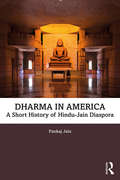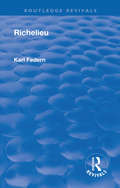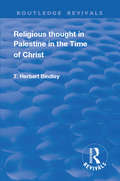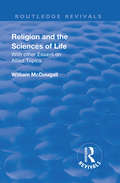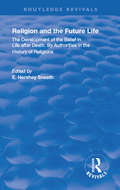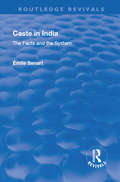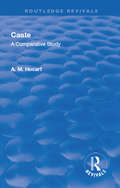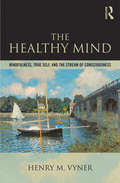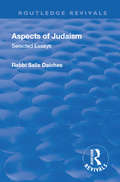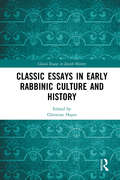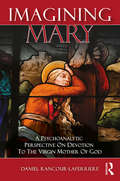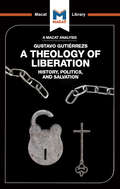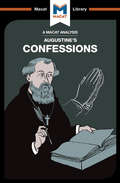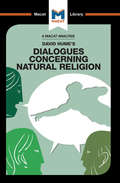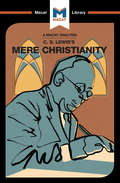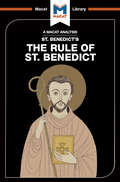- Table View
- List View
Dharma in America: A Short History of Hindu-Jain Diaspora
by Pankaj JainAmerica now is home to approximately five million Hindus and Jains. Their contribution to the economic and intellectual growth of the country is unquestionable. Dharma in America aims to explore the role of Hindu and Jain Americans in diverse fields such as: education and civic engagements medicine and healthcare music. Providing a concise history of Hindus and Jains in the Americas over the last two centuries, Dharma in America also gives some insights into the ongoing issues and challenges these important ethnic and religious groups face in America today.
Revival: Richelieu (1928) (Routledge Revivals #No. 48)
by Karl FedernThe Purpose of this history of Cardinal Richelieu is to show the living personality of the man - to show it evolving, reacting to and acted on by other personalities - and to portray the conditions in France as he found them and transformed them. Within such a narrow compass it is not possible to give full particulars of the sources on which this biography is based. It is a remarkable fact that in French literature apart from works by the cardina;'s contemporaries, there is no biography of Richelieu, and the great work projected by Gabriel Hanotaux has been left uncompleted.
Revival: Richelieu (Routledge Revivals)
by Karl FedernThe Purpose of this history of Cardinal Richelieu is to show the living personality of the man - to show it evolving, reacting to and acted on by other personalities - and to portray the conditions in France as he found them and transformed them. Within such a narrow compass it is not possible to give full particulars of the sources on which this biography is based. It is a remarkable fact that in French literature apart from works by the cardina;'s contemporaries, there is no biography of Richelieu, and the great work projected by Gabriel Hanotaux has been left uncompleted.
Revival: Religious Thought In Palestine In The Time Of Christ (1931) (Routledge Revivals)
by T.H. BindleyThis book is an attempt to bring together from many sources some of the more prominent features of the social, religious, and literary background of the New Testament – an endeavour to capture so far as is possible the atmosphere of thought and feeling in which our Lord and His contemporaries lived.
Revival: Religious Thought in Palestine in the time of Christ (Routledge Revivals)
by T.H. BindleyThis book is an attempt to bring together from many sources some of the more prominent features of the social, religious, and literary background of the New Testament – an endeavour to capture so far as is possible the atmosphere of thought and feeling in which our Lord and His contemporaries lived.
Revival: With Other Essays and Allied Topics (Routledge Revivals)
by McDougall WilliamIn author's own words In selecting these essays I have been guided partly by the desire to present matter likely to be of interest to the general reader; but also I have aimed at a certain unity of topic and argument, a unity indicated by the title of the volume. A brief summary may help the reader to grasp that unity and to follow the somewhat scattered argument. Man, I contend, is more than a machine, and more than a mirror that reflects the world about him. He is an active being with power to direct his strivings towards ideal goals; and there is ground for belief that those goals are neither wholly illusory nor wholly unattainable. There is no novelty about this view; but there is novelty in the argument by which the conclusion is reached. The same view has been propounded a thousand times by that form of wishful thinking which is commonly called philosophical. In this case the conclusion has been forced by the pressure of the evidence during more than forty years of cold and sceptical inquiry. The process is indicated in briefest outline in the first three essays of this volume. Any reader who may desire to follow the process in more detail may turn to my various published works, more especially to my Body and Mind, which remains pivotal for all my later thinking.
Revival: With Other Essays and Allied Topics (Routledge Revivals)
by McDougall WilliamIn author's own words In selecting these essays I have been guided partly by the desire to present matter likely to be of interest to the general reader; but also I have aimed at a certain unity of topic and argument, a unity indicated by the title of the volume. A brief summary may help the reader to grasp that unity and to follow the somewhat scattered argument. Man, I contend, is more than a machine, and more than a mirror that reflects the world about him. He is an active being with power to direct his strivings towards ideal goals; and there is ground for belief that those goals are neither wholly illusory nor wholly unattainable. There is no novelty about this view; but there is novelty in the argument by which the conclusion is reached. The same view has been propounded a thousand times by that form of wishful thinking which is commonly called philosophical. In this case the conclusion has been forced by the pressure of the evidence during more than forty years of cold and sceptical inquiry. The process is indicated in briefest outline in the first three essays of this volume. Any reader who may desire to follow the process in more detail may turn to my various published works, more especially to my Body and Mind, which remains pivotal for all my later thinking.
Revival: The Development of the Belief in Life After Death By Authorities in the History of Religions (Routledge Revivals)
by E. Hershey SneathThis book discusses the in-depth history regarding the development of the belief in the Life After Death, including incites from across history and culture. From Ancient Egyptian and Persian beliefs to modern Christianity and Islam.
Revival: The Development of the Belief in Life After Death By Authorities in the History of Religions (Routledge Revivals)
by Elias Hershey SneathThis book discusses the in-depth history regarding the development of the belief in the Life After Death, including incites from across history and culture. From Ancient Egyptian and Persian beliefs to modern Christianity and Islam.
Revival: The Facts and the System (Routledge Revivals)
by ÉMile Charles SenartThe aim of this book is to discover in what light the religious and literary tradition of India appears where caste is concerned; including discussions on the present system, the past, and its origins.
Revival: The Facts and the System (Routledge Revivals)
by ÉMile Charles SenartThe aim of this book is to discover in what light the religious and literary tradition of India appears where caste is concerned; including discussions on the present system, the past, and its origins.
Revival: A Comparative Study (Routledge Revivals)
by Arthur Maurice HocartThe aim of this book is to persuade the reader that the Indian caste system is not the isolated phenomenon it is often thought to be. But a species of a very widespread genus. Not being an isolated phenomenon, it cannot be understood in isolation; it will merely be misunderstood. More than once it will be shown in these pages how localised specialism leads why from the truth and comparative study returns to it. Comparison also saves time by cutting the tangled knots which controversy ties round texts.
Revival: A Comparative Study (Routledge Revivals)
by Arthur Maurice HocartThe aim of this book is to persuade the reader that the Indian caste system is not the isolated phenomenon it is often thought to be. But a species of a very widespread genus. Not being an isolated phenomenon, it cannot be understood in isolation; it will merely be misunderstood. More than once it will be shown in these pages how localised specialism leads why from the truth and comparative study returns to it. Comparison also saves time by cutting the tangled knots which controversy ties round texts.
The Healthy Mind: Mindfulness, True Self, and the Stream of Consciousness
by Henry VynerIn The Healthy Mind, Dr. Henry M. Vyner presents the findings of twenty-seven years of research spent interviewing Tibetan lamas about their experiences of the mind. The interviews have generated a science of stream of consciousness that demonstrates that the healthy human mind is the egoless mind, given the paradox that the egoless mind has an ego. Vyner presents this science and also shows his readers how to cultivate a healthy mind. The Healthy Mind features extensive interview excerpts, theoretical maps of the egoless and egocentric mind, discussions of the history of science, and thought experiments that unpack the implications of his findings. This is a useful book for all those interested in the dialogue between Buddhism and psychology and in understanding the nature of the healthy mind.
The Healthy Mind: Mindfulness, True Self, and the Stream of Consciousness
by Henry VynerIn The Healthy Mind, Dr. Henry M. Vyner presents the findings of twenty-seven years of research spent interviewing Tibetan lamas about their experiences of the mind. The interviews have generated a science of stream of consciousness that demonstrates that the healthy human mind is the egoless mind, given the paradox that the egoless mind has an ego. Vyner presents this science and also shows his readers how to cultivate a healthy mind. The Healthy Mind features extensive interview excerpts, theoretical maps of the egoless and egocentric mind, discussions of the history of science, and thought experiments that unpack the implications of his findings. This is a useful book for all those interested in the dialogue between Buddhism and psychology and in understanding the nature of the healthy mind.
Revival: Selected Essays (Routledge Revivals)
by Rabbi Salis DaichesAddressed to Jews and non-Jews alike, though aware that these two reader groups were likelyn to approach the book with very different presuppositions, Daiches sets out to define Judaism in relation to philosophy, to explain Kant’s philosophy through the superiority of halakhah, defend a biblically based Jewish interpretation of history, and champion Judaism as a religion of freedom guaranteed by halakhah (Jewish law).
Revival: Selected Essays (Routledge Revivals)
by Rabbi Salis DaichesAddressed to Jews and non-Jews alike, though aware that these two reader groups were likelyn to approach the book with very different presuppositions, Daiches sets out to define Judaism in relation to philosophy, to explain Kant’s philosophy through the superiority of halakhah, defend a biblically based Jewish interpretation of history, and champion Judaism as a religion of freedom guaranteed by halakhah (Jewish law).
Classic Essays in Early Rabbinic Culture and History (Classic Essays in Jewish History)
by Christine HayesThis volume brings together a set of classic essays on early rabbinic history and culture, seven of which have been translated into English especially for this publication. The studies are presented in three sections according to theme: (1) sources, methods and meaning; (2) tradition and self-invention; and (3) rabbinic contexts. The first section contains essays that made a pioneering contribution to the identification of sources for the historical and cultural study of the rabbinic period, articulated methodologies for the study of rabbinic history and culture, or addressed historical topics that continue to engage scholars to the present day. The second section contains pioneering contributions to our understanding of the culture of the sages whose sources we deploy for the purposes of historical reconstruction, contributions which grappled with the riddle and rhythm of the rabbis’ emergence to authority, or pierced the veil of their self-presentation. The essays in the third section made contributions of fundamental importance to our understanding of the broader cultural contexts of rabbinic sources, identified patterns of rabbinic participation in prevailing cultural systems, or sought to define with greater precision the social location of the rabbinic class within Jewish society of late antiquity. The volume is introduced by a new essay from the editor, summarizing the field and contextualizing the reprinted papers. About the series Classic Essays in Jewish History (Series Editor: Kenneth Stow) The 6000 year history of the Jewish peoples, their faith and their culture is a subject of enormous importance, not only to the rapidly growing body of students of Jewish studies itself, but also to those working in the fields of Byzantine, eastern Christian, Islamic, Mediterranean and European history. Classic Essays in Jewish History is a library reference collection that makes available the most important articles and research papers on the development of Jewish communities across Europe and the Middle East. By reprinting together in chronologically-themed volumes material from a widespread range of sources, many difficult to access, especially those drawn from sources that may never be digitized, this series constitutes a major new resource for libraries and scholars. The articles are selected not only for their current role in breaking new ground, but also for their place as seminal contributions to the formation of the field, and their utility in providing access to the subject for students and specialists in other fields. A number of articles not previously published in English will be specially translated for this series. Classic Essays in Jewish History provides comprehensive coverage of its subject. Each volume in the series focuses on a particular time-period and is edited by an authority on that field. The collection is planned to consist of 10 thematically ordered volumes, each containing a specially-written introduction to the subject, a bibliographical guide, and an index. All volumes are hardcover and printed on acid-free paper, to suit library needs. Subjects covered include: The Biblical Period The Second Temple Period The Development of Jewish Culture in Spain Jewish Communities in Medieval Central Europe Jews in Medieval England and France Jews in Renaissance Europe Jews in Early Modern Europe Jews under Medieval Islam Jews in the Ottoman Empire and North Africa
Imagining Mary: A Psychoanalytic Perspective on Devotion to the Virgin Mother of God
by Daniel Rancour-LaferriereImagining Mary breaks new ground in the long tradition of Christian mariology. The book is an interdisciplinary investigation of some of the many Marys, East and West, from the New Testament Mary of Nazareth down to Our Lady of the Good Death in the twentieth century. In Imagining Mary, Professor Rancour-Laferriere examines the mother of God in her multireligious and pan-historical context. The book is a scholarly study, but it is written in a clear, straightforward style and will be comprehensible to an educated – and, above all, intellectually curious – general audience. It will appeal to anyone who has ever wondered, for example, about the flimsy scriptural basis of many beliefs about Mary; or the tendency of many mariologists to depict Mary as an incestuous "bride of Christ"; or the theological notion of Mary’s "loving consent" to her son’s crucifixion; or the idea that Mary was a "priest" officiating at the sacrifice of her son; or the unfortunate association of Mary with Christian anti-semitism; or the curious appeal of Mary to the terminally ill; and so on. Special attention is given to the psychology of representations of Mary, such as: the psychological basis for promoting Mary to the status of a "goddess"; the psychology of Mary’s compassion for her son at the foot of the cross; and the psychological conflict in Mary’s personal relationship with her son Jesus. These topics are admittedly diverse, but they all have long been on the minds of mariologists. The author takes a questioning approach to received wisdom about marian themes – including the assumption that one has to be a theist in order to understand the great appeal of Mary down the centuries. Indeed, Imagining Mary may be regarded as a first step in the direction of an atheist mariology.
Imagining Mary: A Psychoanalytic Perspective on Devotion to the Virgin Mother of God
by Daniel Rancour-LaferriereImagining Mary breaks new ground in the long tradition of Christian mariology. The book is an interdisciplinary investigation of some of the many Marys, East and West, from the New Testament Mary of Nazareth down to Our Lady of the Good Death in the twentieth century. In Imagining Mary, Professor Rancour-Laferriere examines the mother of God in her multireligious and pan-historical context. The book is a scholarly study, but it is written in a clear, straightforward style and will be comprehensible to an educated – and, above all, intellectually curious – general audience. It will appeal to anyone who has ever wondered, for example, about the flimsy scriptural basis of many beliefs about Mary; or the tendency of many mariologists to depict Mary as an incestuous "bride of Christ"; or the theological notion of Mary’s "loving consent" to her son’s crucifixion; or the idea that Mary was a "priest" officiating at the sacrifice of her son; or the unfortunate association of Mary with Christian anti-semitism; or the curious appeal of Mary to the terminally ill; and so on. Special attention is given to the psychology of representations of Mary, such as: the psychological basis for promoting Mary to the status of a "goddess"; the psychology of Mary’s compassion for her son at the foot of the cross; and the psychological conflict in Mary’s personal relationship with her son Jesus. These topics are admittedly diverse, but they all have long been on the minds of mariologists. The author takes a questioning approach to received wisdom about marian themes – including the assumption that one has to be a theist in order to understand the great appeal of Mary down the centuries. Indeed, Imagining Mary may be regarded as a first step in the direction of an atheist mariology.
A Theology of Liberation (The Macat Library)
by Jonathan Teubner Marthe HesselmansPeruvian priest Gustavo Gutiérrez wanted to solve the problem of how the church could conduct itself to improve the lives of the poor, while consistently positioning itself as politically neutral. Despite being a deeply religious man, Gutiérrez was extremely troubled by the lukewarm way in which Christians in general, and the Catholic Church in particular, acknowledged and supported the poor. In A Theology of Liberation, he asked what he knew was an awkward question, and came to an awkward answer: the Church cannot separate itself from economic and political realities. Jesus showed his love for the poor in practical ways – healing the sick, feeding the hungry, liberating the oppressed. His example showed Gutierrez that economic, political, social and spiritual development are all deeply connected. His problem-solving prowess then led him to conclude that the church had to become politically active if it was to confront poverty and oppression across the world. For Gutierrez, the lives of the poor and oppressed directly reflect the divine life of God.
Confessions (The Macat Library)
by Jonathan TeubnerSt. Augustine’s Confessions is one of the most important works in the history of literature and Christian thought. Written around 397, when Augustine was the Christian bishop of Hippo (in modern-day Algeria), the Confessions were designed both to spiritually educate those who already shared Augustine’s faith, and to convert those who did not. Augustine did this through the original maneuver of writing what is now recognized as being the first Western autobiography – letting readers share in his own experiences of youth, sin, and eventual conversion. The Confessions are a perfect example of using reasoning to subtly bring readers around to a particular point of view – with Augustine inviting them to accompany him on his own spiritual journey towards God so they could make their own conversion. Carefully structured, the Confessions run from describing the first 43 years of Augustine’s life in North Africa and Italy, to discussing the nature of memory, before moving on to analyzing the Bible itself. In order, the sections form a carefully structured argument, moving from the personal to the philosophical to the contemplative. In the hundreds of years since they were first published, they have persuaded hundreds of thousands of readers to recognize towards the same God that Augustine himself worshipped.
Dialogue Concerning Natural Religion (The Macat Library)
by John Donaldson Ian JacksonDavid Hume’s Dialogues Concerning Natural Religion is a philosophical classic that displays a powerful mastery of the critical thinking skills of reasoning and evaluation. Hume’s subject, the question of the existence and possible nature of God, was, and still is, a persistent topic of philosophical and theological debate. What makes Hume’s text a classic of reasoning, though, is less what he says, than how he says it. As he noted in his preface to the book, the question of ‘natural religion’ was unanswerable: so ‘obscure and uncertain’ that ‘human reason can reach no fixed determination with regard to it.’ Hume chose, as a result, to cast his thoughts on the topic in the form of a dialogue – allowing different points of view to be reasoned out, evaluated and answered by different characters. Considering and judging different or opposing points of view, as Hume’s characters do, is an important part of reasoning, and is vital to building strong persuasive arguments. Even if, as Hume suggests, there can be no final answer to what a god might be like, Dialogues Concerning Natural Religion shows high-level reasoning and evaluation at their best.
Mere Christianity (The Macat Library)
by Mark ScarlataC.S. Lewis’s Mere Christianity is a perfect example of one of the most effective aspects of critical thinking skills: the use of reasoning to build a strong, logical argument. ¶Lewis originally wrote the book as a series of radio talks given from 1942-1944, at the height of World War II. The talks were designed to lay out the most basic tenets of Christianity for listeners, and to use these to make a logical argument for Christian belief and Christian ethics. While Lewis was not an academically-trained theologian or philosopher (specializing instead in literature), his own experience of converting from atheism to Christianity, along with his wide reading and incisive questioning, power a charming but persuasive argument for his own beliefs. ¶Whether or not one agrees with Lewis’s arguments or shares his faith, Mere Christianity exemplifies one of the most useful aspects of good reasoning: accessibility. When using reasoning to construct a convincing argument, it is crucial that your audience follow you, and Lewis was a master at constructing well-organised arguments that are immediately understandable to readers. The beautifully written Mere Christianity is a masterclass in cogently walking an audience through an elegant and well thought-through piece of reasoning.
Rule of St Benedict (The Macat Library)
by Benjamin LairdThe Rule of St Benedict, written around 1500 years ago by the Italian monk St Benedict of Nursia, is a slim handbook for monastic life – a subject many modern readers would regard as relatively niche. It is, however, also a model of the organized and clearly expressed thought produced by good reasoning skills – a mainstay of critical thinking. Reasoning is all about making a good case for something, through logical arguments, neatly and systematically organised. In Benedict’s case, his main concern was to lay out a set of rules and practices that would allow monasteries to run as well-organised communities. Communal living presented huge challenges, and yet it was also, Benedict believed, the best way for monks to sustain themselves, their religion, and the learning and teaching that went with it. His Rule laid out concise but detailed chapters on the best way to achieve this, including provisions for all areas of personal and communal discipline, right down to how tasks might be allotted to individual monks. Providing a complete roadmap for successfully running a community, the concise brilliance of The Rule has even been suggested by some business professors as useful model for running small businesses today.
